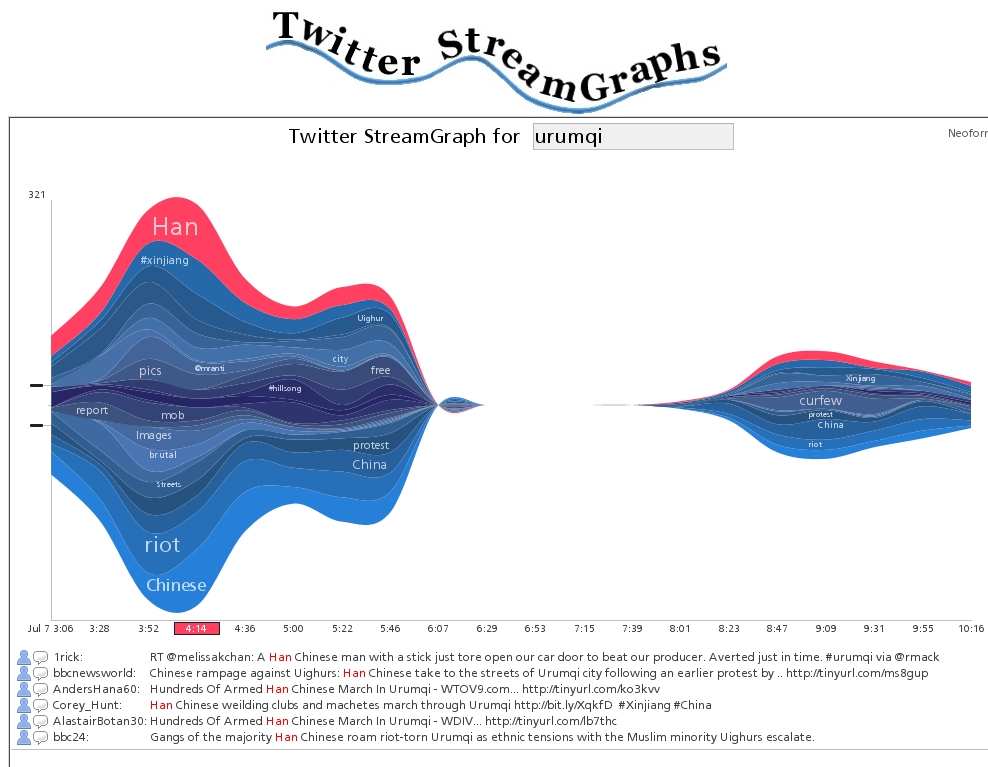
News as Urumqi; how to understand what 'the news' has been and is becoming
G. R. Boynton
First, news to whom? News for fans of Britney Spears would surely be different than for fans of missile defense systems. A house is for sale in a neighborhood in which I would like to live is news for me. And what about Urumqi? Etc. We have, without much thought, let The New York Times -- and others -- be the arbiter of what is and is not news. As the world of communication changes it is surely time to reconsider what we are going to do with 'news.'
Second, all the news that's fit to print: for me that is The Washington Post, for good or ill. So let me look at its version of one piece of news. On Sunday, I have learned, riots broke out in Urumqi, China, which is a place I had never heard of before. This morning, Tuesday, there was a report in The Washington Post. (Ariana Eunjung Cha, July 7, 2009) That is not exactly speedy news coverage. I tried to get 'back' through Twitter, but they will only give you the most recent 1500 tweets, and the earliest I could get was last night, July 6, at 11:06. I assume there were lots before that, but I could have gotten the story at least 13 hours earlier via twitter than I did via the Post. One other bit of 'evidence' from Streamgraphs
 |
|---|
This is the most recent 1,000 tweets about Urumqi arrayed in time. It seems pretty clear that the story was over on Twitter before it was reported by the Post. It got a small bump at about 9:00 a.m. July 7, but it had disappeared before that. Of course, if something else 'dramatic' happens there will surely be more tweets. But the news reported by the Post was over before the Post reported.
What does the story in the Post look like? The sources paragraph by paragraph:
state media
witnesses
official news agency
Associated Press
state media
background provided by writer
analogy drawn by writer
white house press secretary
state TV
news conference person living in exile in D.C.
unsourced
witnesses
quote witness 1
quote witness 2
quote witness 3
background
person living in exile in Sweden
This is not exactly eye witness reporting. The author may have been at the news conference in D.C., but everything else came from a public source of some sort or another. You have to be able to read Chinese to keep up to date with "state media" and "state TV," but there are lots of Chinese readers.
What is the point? This news story is piecing together information that is all over the web. The author has drawn it together for me, but if I was a 'fan' of Urumqi I would surely have known this long before the Post drew it together for me. I surely could have gotten most of this from Twitter -- though Twitter is quintessential not piecing together. And I believe if we looked we would find that much news reporting is bringing together information that would be available -- say, on Twitter -- if you were intent on looking.
And how do we know that too much information is getting 'out' via the new media? China has again blocked Twitter and Facebook (Stan Schroder, July 7, 2009)
The economic institutional structure that has supported 'the news' for the last century or two is falling away. The news is going to be remade without much left of what we have known as news media. It is an exciting time for journalists -- most of whom hate the changes that are enveloping them. But it is an equally exciting time for people interested in communication and politics. We need to be paying careful attention to the changes that are transpiring.
Ariana Eunjung Cha (July 7, 2009) Scores Killed in Ethnic Riots in China, The Washington Post.
Stan Schroeder (July 7, 2009) China Blocks Twitter and Facebook . . . Again, Mashable